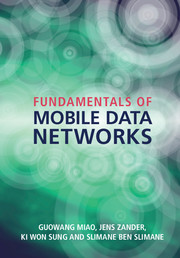Book contents
- Frontmatter
- Contents
- Preface
- Acronyms
- Notations
- 1 Introduction
- 2 Wireless network models
- 3 Medium access control
- 4 Scheduling
- 5 Principles of cellular systems
- 6 Transmitter power control
- 7 Interference management
- 8 Association and handover
- 9 Energy-efficient design
- 10 Long term evolution
- 11 Wireless infrastructure economics
- About the authors
- Index
- References
2 - Wireless network models
Published online by Cambridge University Press: 05 March 2016
- Frontmatter
- Contents
- Preface
- Acronyms
- Notations
- 1 Introduction
- 2 Wireless network models
- 3 Medium access control
- 4 Scheduling
- 5 Principles of cellular systems
- 6 Transmitter power control
- 7 Interference management
- 8 Association and handover
- 9 Energy-efficient design
- 10 Long term evolution
- 11 Wireless infrastructure economics
- About the authors
- Index
- References
Summary
Introduction
Looking at classical communication theory, we see that it mainly deals with point-to-point links disturbed by thermal (Gaussian) noise. More recently the challenges of mobile communication have introduced features such as adverse, time-varying propagation conditions which create channel variations that are difficult to predict. Radio systems, as we find them in reality, have to cope with additional problems. Maybe the most characteristic feature of modern radio communication is that virtually no radio link or radio system operates in isolation, and is thus never alone in its allocated frequency band. Other radio transmitters, near and far, constantly cause interference. Interference is in many cases the limiting factor to the performance of the system. Since the days of Marconi, the proliferation of wireless communications has caused a tremendous increase in the utilization of the frequency spectrum. A key problem area, as was already noted in Chapter 1, is how to manage the frequency spectrum to avoid, or at least minimize, the adverse effects of interference. Can interference be avoided completely, or are there efficient methods to minimize the performance degradation? The ether, where we transmit our signals, is, whether intended or not, a broadcast medium. In some geographical regions, a large number of wireless networks have to coexist as illustrated in Figure 2.1. The blessing of wireless communication is that it allows for quickly establishing arbitrary new connections between a large number of users. In Figure 2.1, we consider three transmitters transmitting information to three different receivers indicated by the solid black arrows. We call these paths the active communication links. As the radio spectrum is shared by all users the transmissions of the three transmitters in Figure 2.1 give rise to interference. These unwanted cross-links, the interference links, are indicated by the light gray arrows in the figure.
The properties of the interference will depend on the waveforms and transmitter powers selected by the interfering transmitters as well as the propagation conditions on the cross-links. The impact on the performance of the active communication link will depend not only on the waveforms, the powers and the propagation conditions in the active link but also on the performance of the radio receiver, e.g. how good the receiver is at suppressing the unwanted signals. The performance experienced by the user in this network will depend on the type of service that is provided.
- Type
- Chapter
- Information
- Fundamentals of Mobile Data Networks , pp. 12 - 26Publisher: Cambridge University PressPrint publication year: 2016
References
- 1
- Cited by



